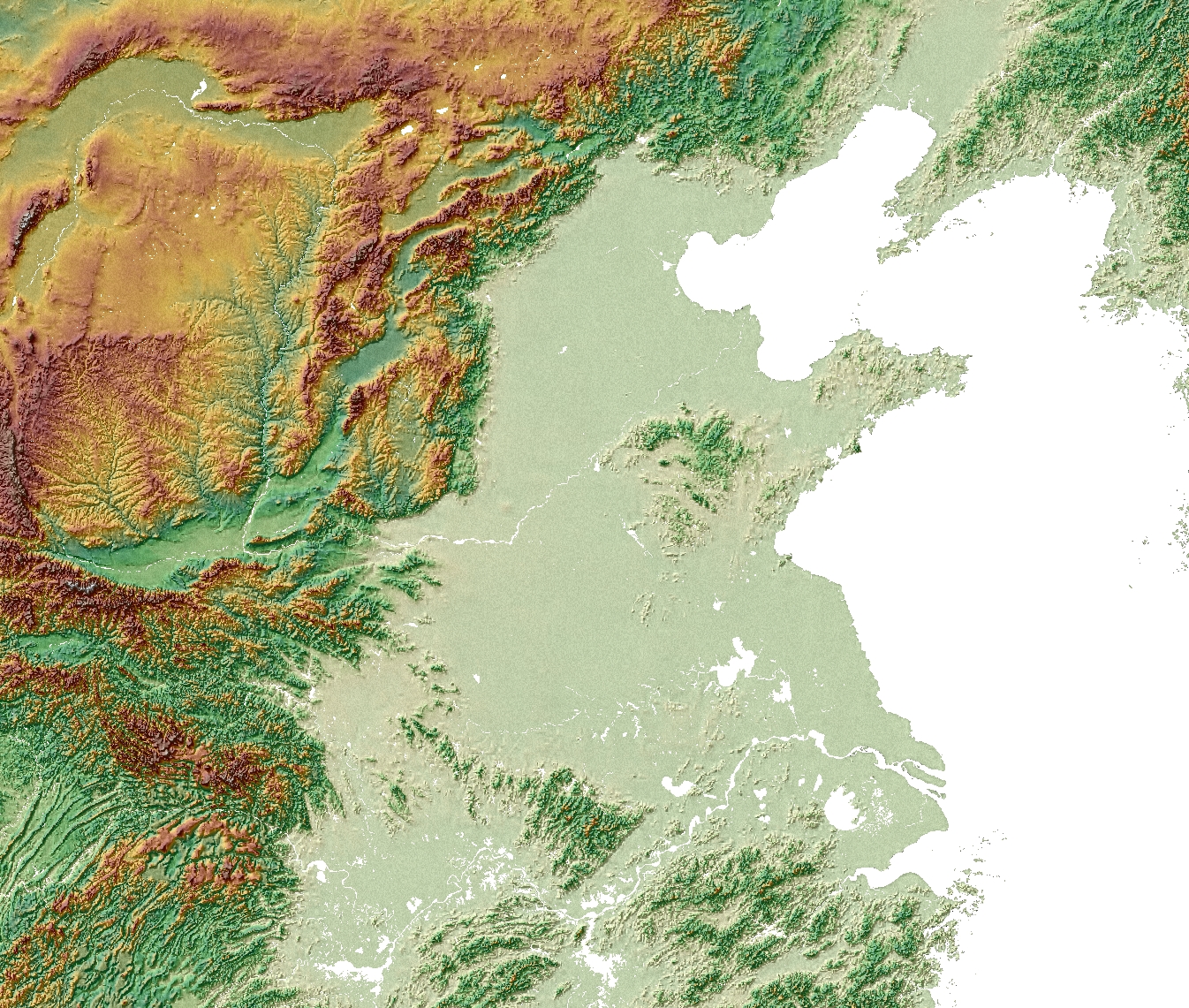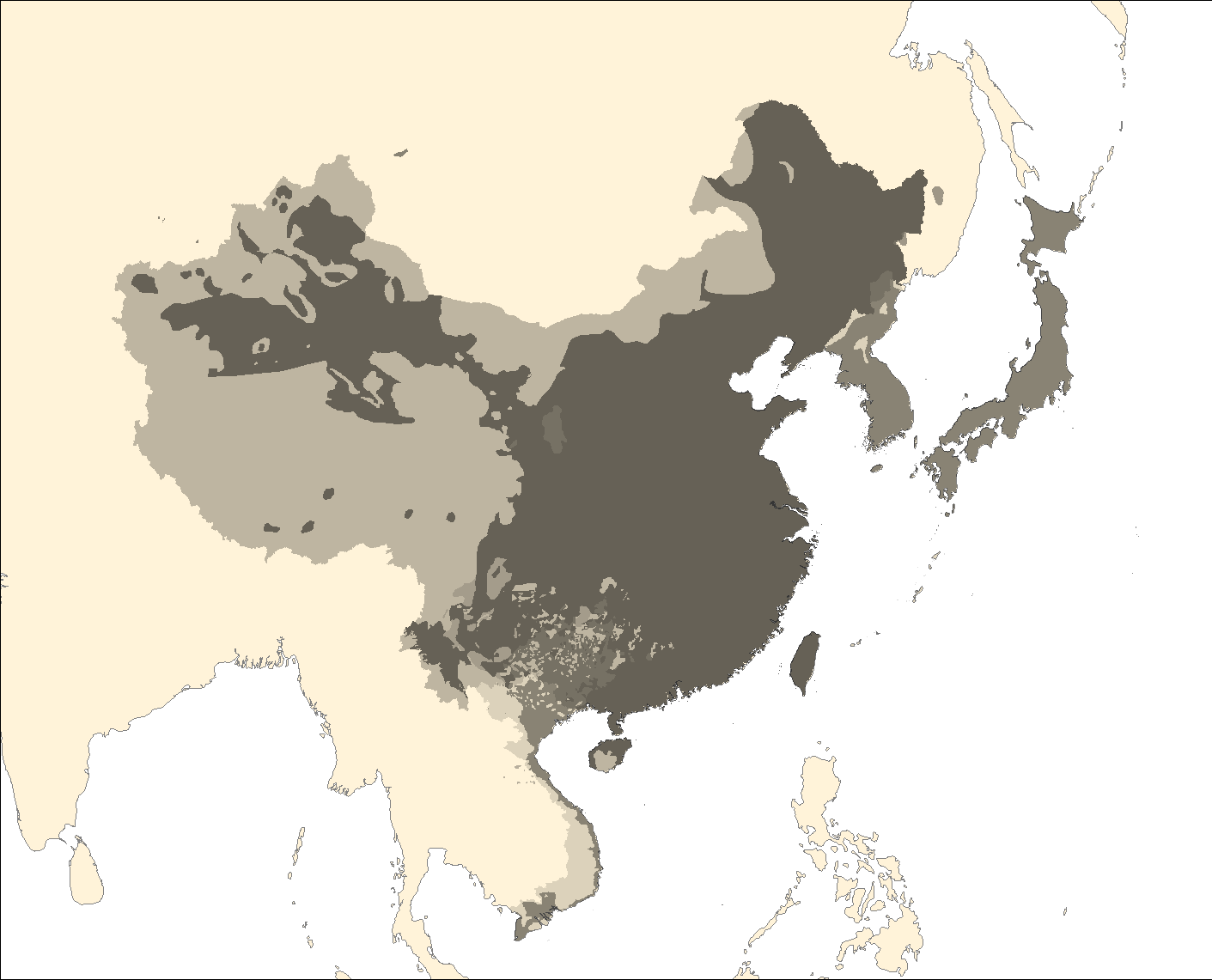|
Sino-Asia is the cultural sphere of Chinese civilization and all those cultures heavily influenced by it. Aside from the Chinese themselves (that is, speakers of the Sinitic dialects), the Sino-Asians include the Japanese, Koreans, Vietnamese, and some of the Tai, considered as peoples.
The main elements of this shared Sino-Asian culture are Chinese religion, inherited or borrowed Sinitic vocabulary, and the present or traditional use of the Chinese script.
 Chinese civilization began along the Yellow River (黃河 « Xuaŋ35 Xə35 ») and across the North China Plain (shown at left), which is still a major concentration of population, inhabited by the Han (漢 « Xan51 »), the cultural and ethnic group responsible for Chinese culture. Chinese civilization began along the Yellow River (黃河 « Xuaŋ35 Xə35 ») and across the North China Plain (shown at left), which is still a major concentration of population, inhabited by the Han (漢 « Xan51 »), the cultural and ethnic group responsible for Chinese culture.
Chinese religion is an amalgam of Confucianism, Taoism, Taoist-influenced Buddhism, and folk beliefs. Within the Sino-Asian context, the component of the folk beliefs that exists in the amalgam is ancestor worship. All four of these components exist to some degree throughout Sino-Asia, even when not explicit. For example, Sino-Asians will not necessarily identify themselves as Confucian, but they will hold values that are derived from Confucian ethics. While each component has been at times an independent religion, today they exist primarily in the pluralist combination.
The Sinitic dialects exist as a dialect continuum that runs primarily along the coast of China, extending about 500-600 km inland. All other regions in the Sinitic-speaking area use an extension of one of those coastal dialects, primarily Mandarin (漢語 « Xan51 Ü214 » / 普通話 « P‛u214 T‛uŋ5 Xua51 »). Those Sino-Asian cultures that are not themselves Sinitic have borrowed extensive amounts of Sinitic vocabulary (to emphasize, this means that they have borrowed Sinitic vocabulary into their speech; writing is a different matter). This borrowed vocabulary is even identified as such: Sino-Japanese, Sino-Korean, Sino-Vietnamese.
The Chinese script (漢字 « xan51 ci51 ») was developed (presumably) for writing Sinitic; since it originally lacked a phonetic component, this cannot be conclusively known. But it is used to represent all the Sinitic dialects today. It is also used, alongside native characters, to write Japanese; individual characters can be read as different Japanese words, generally representing the native Japanese vocabulary, and Sino-Japanese vocabulary borrowed during two different eras (thus, the same character might represent three different Japanese words, with similar but not identical meanings). Korean was traditionally written in Chinese script; educated South Koreans still know the script to greater or lesser extents, but everyday writing has long been (and in the North, is exclusively) through a native script, hangul (한글 « han kul »). Chinese script holds the same place in Vietnamese culture, but the supplanting script is this case is Latin.
There are other shared cultural features in Sino-Asia. The most famous is surely the use of chopsticks. Sino-Asian personal names follow a distinctive pattern, with the family name placed first, the personal name second. The typical pattern in Chinese is a monosyllabic family name and a disyllabic personal name. The pattern is followed in Korean and Vietnamese as well, with the syllables themselves often or perhaps usually drawn from Sino-Korean and Sino-Vietnamese. In Vietnamese, the two syllables of the personal name are distinct, and the second serves as the idiomatic short form (with titles, for instance), while in the rest of Sino-Asia, the family name has that role. Japanese names are frequently multisyllabic; uniquely for Sino-Asia, the Japanese name is typically reordered in an English context.
In the scheme of world regions, which are large primary divisions of the world used in higher education and particulary as the basis for area studies, East Asia is clearly based on Sino-Asia. Conventionally East Asia is defined by countries, and includes the entirety of the countries of China, Japan, and North and South Korea, as well as Taiwan, if that is counted as a separate country. The country of Vietnam is placed instead in Southeast Asia.
|
|

Shading indicates the presence of Sinitic dialects, borrowed Sinitic vocabulary, present or historical use of Chinese script, present Chinese rule, and present Sino-Asian rule; darker shades indicate presence of more features. Spatial data from National Geographic and SIL/WLMS.
|

